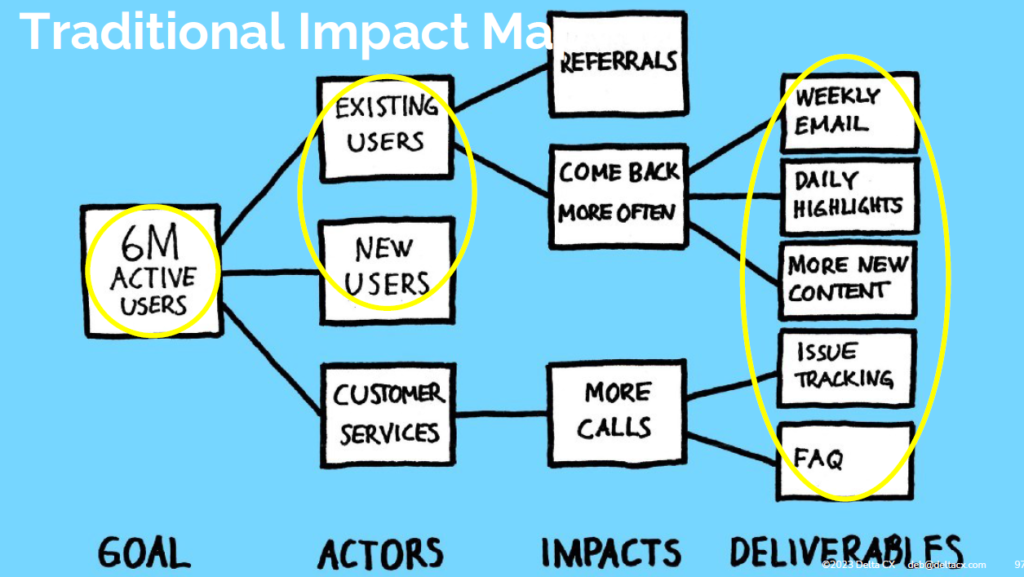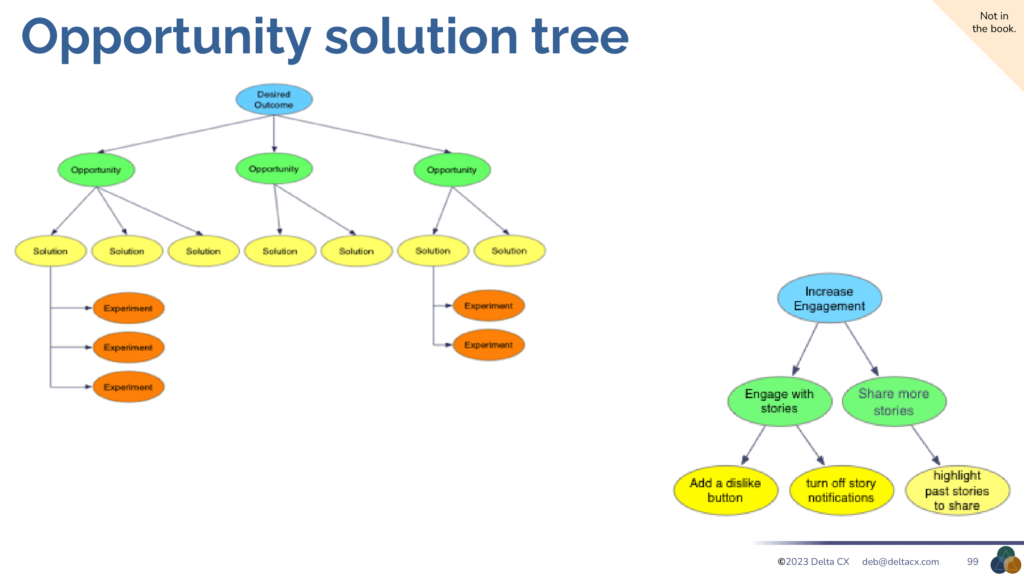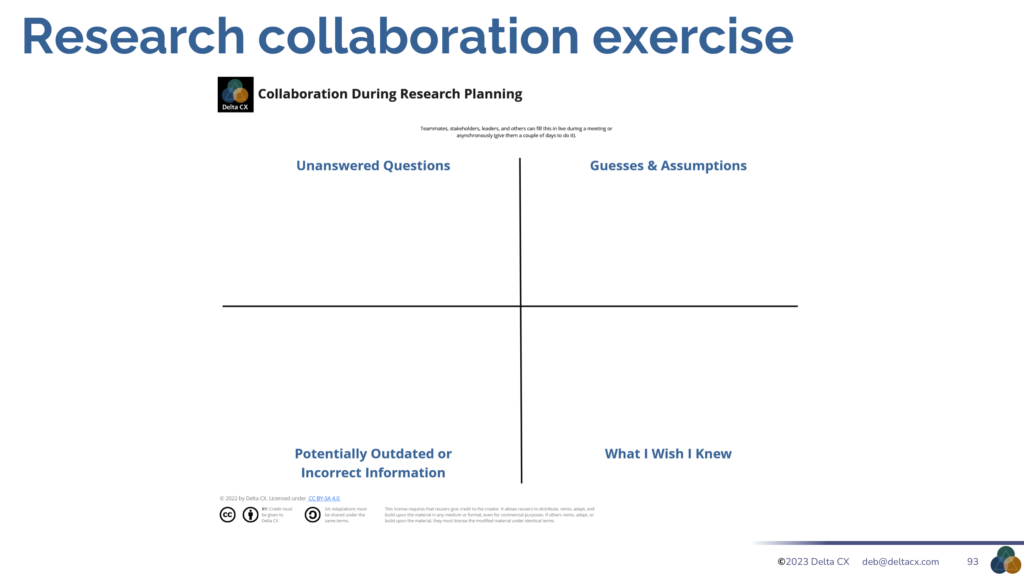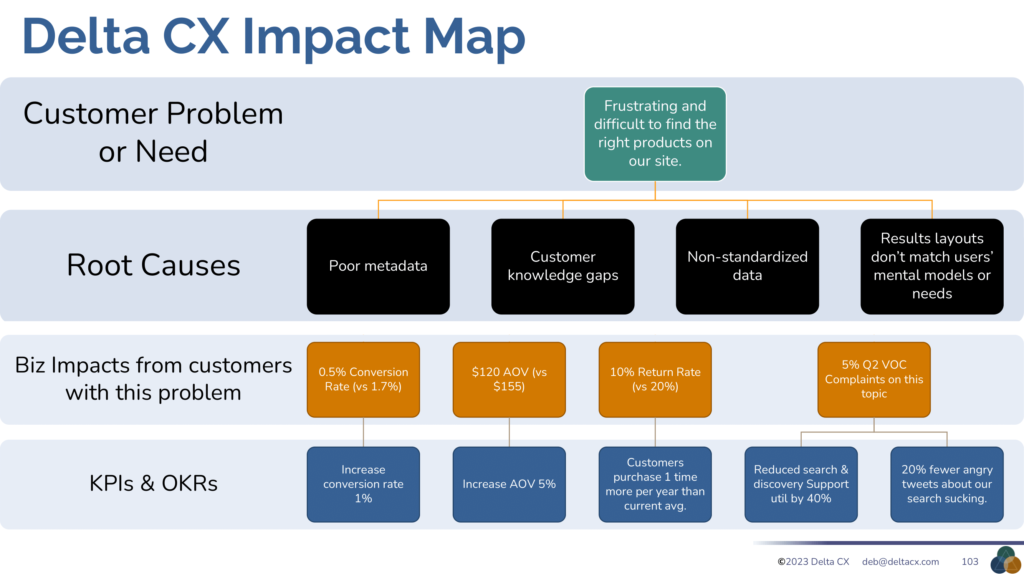Not too long ago, we had the pleasure of another visit from Debbie Levitt, CXO of Delta CX. She once again came as a guest speaker to our webinar to brush off the non-customer-centric dust from some commonly used CX/UX methodologies.
Thanks to Debbie, you might have already made your journey map actionable. If you're ready for the next step — making truly customer-centric impact maps — let's dive into this article together.
Video recording
If by any chance you're not in the mood for reading but still up for a productive and enjoyable hour on YouTube, check out the recording of Debbie's talk that served as the foundation for the article:
Contents
Traditional impact maps vs. customer-centric impact maps
When we google impact maps, traditional impact mapping is usually shown as a left-to-right tree.

The tree starts with the primary goal, which is typically what the business wants to achieve, such as an increased number of active users or higher conversion rates.
The second level of the hierarchy, actors, branches out from the primary goal. These actors can be personas, market segments, target audiences, or internal teams.
The third level of the tree is the impacts. From a business perspective, these impacts are often connected to customer success. Examples of impacts include getting more referrals, higher purchase frequency, or viewing more ads.
Moving on to the fourth level of the tree — the deliverables. It presents high-level solutions for creating these impacts, which will ultimately help us achieve our goal. Some examples of deliverables are increased communication, sales promotions, weekly emails, daily highlights, new content, internal issue tracking, and FAQs.
This approach to impact mapping is credited to Gojko Adzic. But while a standard impact map can be useful, it has some weaknesses. As someone who values critical thinking, you should ask why this approach starts with a business goal. If a business goal is not based on a deep understanding of customers and users, it may not be a customer-centric goal. This kind of impact mapping is about pushing customers and users towards the business goal.
But what about customers and users? Why should they increase their purchasing frequency or engage with more ads? Is it really what they want for themselves? Will implementing an FAQ section really result in more active users? What about creating more content — do we know what types of content our customers actually want or need? Or are we simply making assumptions and guesses because customers seem unhappy with our services, with complaints piling up in the backlog and support unable to address concerns quickly enough?
We may prioritize the wrong things — both an FAQ and more content may be mere guesses. We may not truly understand what our users and customers need. These deliverables may not achieve the impact or business goals we're hoping for. We've all been in those meetings where everyone is shrugging their shoulders, wondering why we were so convinced that adding more content, sending weekly emails, or creating an FAQ would grow the active user base.
And amazingly, despite our best efforts, it didn't help to grow the active user base. We're unsure what went wrong since we were so confident we had a solid plan to achieve the desired business impact.
There’s another issue — we didn't map out the actual problems our customers are facing. But if our impact map templates don't include information about customer pain points, unmet needs, or other problems they have, we're unlikely to arrive at customer-centric solutions.
So, at present, most impact maps aren't customer-centric impact maps. Users and customers aren't really part of the conversation. We are only considering how we can influence their behavior to meet our business objectives. There are plenty of impact maps that add hypotheses, experiments, KPIs, and other steps, but they still don't address the core problem of not being customer-centric. If we're starting with a business goal and just treating the users as pawns, we're not really doing anything that's customer-focused.
In my opinion, this is actually anti-customer-centric — something I like to call "customer-peripheric”, — says Debbie Levitt, CXO of Delta CX.
Opportunity Solution Trees, or impact maps’ cousins
Are you familiar with Opportunity Solution Trees, developed by Teresa Torres?

Those are similar to impact maps, as they, too, prioritize business goals and try to manipulate customers.
How’s that? You start with a business objective without putting the customer at the center, and instead of delivering solutions and business impacts, map out opportunities related to the desired outcome. From there, you can develop solutions and conduct experiments to test their effectiveness. But how to identify the opportunities?
In 2016, Teresa Torres proposed using generative research for that purpose. She meant early CX or UX research that examines people's behaviors, habits, tasks, perspectives, and unmet needs. It usually involves observing and interviewing people to get the necessary details and evidence to guide product and service strategies.
Let’s review an example used by Teresa on her website. The business objective was to increase engagement across social media pages, and the research revealed that the identified opportunities were to engage with stories and share more stories. But is that true? Did the research team simply send out a survey asking users if they wanted more stories, or did they observe users struggling to engage with stories and identify specific pain points?
There's a real risk that these "opportunities" are nothing more than guesses or solutions looking for a problem to solve. Even if we conduct good generative research, we must avoid writing our opportunities as features, like "make people engage with stories". Instead, we should focus on the actual pain points and unmet needs to address with solutions.
It's unlikely that people have an unmet need to engage more with stories — if we're mapping opportunities, they should be solution-agnostic and truly customer-centric. An opportunity should address a problem we know exists for users but that our company hasn't yet explored.
Overall, we must be suspicious of these maps, trees, and diagrams — they can be "garbage in, garbage out". We should apply critical thinking consistently and be on the lookout for garbage, removing it when necessary. Finally, we must remain mindful that the business objectives may not always align with what customers want or need.
Business value or customer’s need?
Earlier this year, Teresa Torres shared a LinkedIn video discussing a critical aspect of building an Opportunity Solution Tree. In this video, she says that the business need should be the top priority, followed by mapping unmet customer needs, pain points, and desires. Some may question this approach, but Teresa emphasized the importance of creating value for both the customer and the business. Neglecting business value could lead to unviable solutions and even the company’s downfall. Prioritizing business value is crucial for maximizing customer value. Did you catch Teresa's message?
Debbie disagrees with what Teresa shared.
Firstly, no one suggested ignoring business value; that's a strawman argument. However, concentrating on understanding customer needs and delivering value can lead to more business value. Such an approach brings positive outcomes like word of mouth, customer loyalty, increased spending, and frequent purchases. Let's remember that customer focus is essential for building successful teams and companies.
Secondly, using the fear of job loss to promote an idea can stifle creativity and innovation by promoting conformity. While it's true that a solution that lacks business value is unlikely to receive resources and funding, it's equally crucial to consider the needs and tasks of potential and current customers. Neglecting customers' desires may render the solution unviable immediately. Instead of viewing customers' needs in line with pre-existing business objectives, we should seek solutions that cater to both.
When using customer-centric impact maps and opportunity trees effectively, we need to be aware of our assumptions and use research to replace them with verified evidence. However, these tools can only help if we are honest about what we actually know versus what we suspect. Diagrams do not always distinguish between assumptions and verified facts, leading to wrong conclusions. As such, we must remember that these maps serve primarily as informed guesses, especially in areas where we lack sufficient information.
So what do we do then?
The Quadrant exercise: just to be sure
Let’s assume we've conducted thorough research based on evidence. In that case, we filled out our diagrams and maps according to the data collected. However, when running a group brainstorming session, guesses and untested ideas will emerge, making it essential to distinguish them from verified research. These tentative solutions and deliverables should be marked as guesses, hypotheses, or untested ideas.
Yet there's a collaboration exercise Debbie calls the Quadrant Exercise. It helps identify what we don't know, review assumptions we have made, and eliminate outdated or incorrect data before working on a project.

When we lack information, it's easy to feel overwhelmed and confused. That is especially true when it comes to understanding our users. If we haven't done our research in a while, our data may be misleading. The Quadrant Exercise is a great tool that helps us differentiate between facts, opinions, and guesses.
It's essential to invest in early research to minimize risks and avoid costly mistakes. When we have unanswered questions, we're more likely to make uninformed decisions or try to guess. So, gather your team, virtually or in person, and focus on a specific project or area of your products and services. Use online tools to make it more efficient. By practicing the Quadrant Exercise, we can better understand our users, make informed decisions, and avoid costly mistakes.
To complete the Quadrant Exercise, we start by listing all our assumptions, guesses, and knowledge about our users, customers, partners, technology, or capabilities. Having them on the screen helps us ask relevant questions and openly address concerns. Some questions may be out of scope or premature; you can address them later.
This exercise is beneficial at any point in the project, even midway or after an unsuccessful MVP or A/B test. But it's best to start the Quadrant Exercise early in the project planning process, whether during quarterly or release planning or discovery planning. This way, the team can identify potential risks and areas of uncertainty before moving forward.
The exercise involves filling a screen with questions about the project to use them when planning research methods that will provide relevant answers. It's important not to jump to solutions, brainstorming, or guessing, as this can lead to moving too fast without sufficient knowledge.
It's also essential to use critical thinking when it comes to claims about tools like impact maps and Opportunity Solutions Trees being fantastic for team building. While they can be helpful, they're not the only solutions. Otherwise, we would see them used in other areas as well. Yet, these strategies are best suited for UX and designing customer experiences.
And we shouldn't overlook other approaches that may be more effective for building cohesive teams. Instead, reliable sources like New York Times, Forbes, Harvard Business Review, and Entrepreneur suggest getting to know each other, understanding roles and goals, improving communication, and celebrating successes. Welcome input from all team members, even those who point out risks or mistakes. Excluding them can hinder success and lead to failure.
Delta CX Impact Map
If we only expect team members to conform, stay silent, and avoid raising concerns, we're just putting on a show. There’s a more actionable solution that pursues opposite goals — the Delta CX impact map, which you are free to modify for your team's needs.

Such customer-centric impact maps put the customers' goals at the forefront and outlines measurable business impact. By including KPIs and OKRs, they can demonstrate how meeting customer goals drives customer and business success.
The map follows a structured approach, starting with the primary customer problem of difficulty in finding the right products on the website (or with an issue identified in your case). The next level identifies the root causes — based on thorough internal and external research, including user observations.
Any assumptions are labeled and will require further research to corroborate or dispel. Examples of root causes include poor metadata, gaps in customer knowledge, and non-standardized data entered by third parties.
While working with Macy's, Debbie noticed that third-party data entry led to discrepancies and awkward search results. Sometimes, presenting search results in a list format may not align with users' needs or mental models. However, these examples are assumptions, and further research may be necessary to confirm them.
Delta CX’s team doesn't try to guess the root causes of customer problems. After establishing them, they don't have lines connecting those because if a root cause affects multiple business impacts, creating one-to-one relationships doesn't make sense and would only complicate matters. Instead, the third level of their tree specifies the business impact of the customer problem. When customers experience this problem, how does it impact their project, product, or company?
What happened in the sample case?
This sample map above is an example where Debbie investigates the issue by consulting with customer support, sales, and data analytics. To understand the issue better, she looks into different sources of information, including customer complaints, feedback, tweets, and the voice of the customer. This information is not based on guesswork but on thorough research.
In the example, the search function causes lower conversion rates as users get stuck and leave the site, decreased shopping frequency, and lower average order value (AOV). Additionally, high call volumes result in increased customer support costs, so investing in improving the customer experience is crucial. When we disregard the problem, it only perpetuates.
Before we dive deeper, let’s touch on the last part of the tree, which concerns KPIs and OKRs.

Fixing customer problems and addressing root causes won't result in immediate changes at the third, orange level. We must provide conservative estimates of future KPIs and OKRs. For example, if we improve the search function to better align with users' needs, we might see an increase in our conversion rate by 0.5% or 1%. But for making meaningful changes, even small percentage growth matters.
We also need to estimate future KPIs and OKRs conservatively based on our data and research. For instance, we could aim to increase our average order value by 2%, 3%, or 5%, encourage customers to purchase twice a year, or reduce customer support calls related to poor search function by 40%. Aiming to reduce the number of angry tweets by 10%, 15%, or 20% can also improve the customer experience significantly.
Delta CX Impact Map’s superpower
The Delta CX Impact Map does more than align teams and identify root causes. It connects customer problems with business impact, demonstrating their importance to stakeholders and leaders.
Let’s face it; if we inform stakeholders that our search function generates customer complaints and angry tweets, they may ask, "So what?" Stakeholders prioritize revenue and need a compelling reason to address customer problems. An impact map identifying root causes and business impact can make a strong case. Even without a solution, it signals that we understand the issue and can highlight potential profit losses. This approach appeals to bottom-line concerns and places the issue in terms stakeholders are likely to appreciate.
While companies may tout empathy, their primary concern is profit, so we must present the impact map in monetary terms to capture their attention. And by connecting customer problems to business losses or missed goals, we can push companies to build truly customer-centric impact maps and become more customer-centric in general.
The Q&A with Debbie
After the online event focused on customer-centric impact maps, there was a Q&A session with the speaker. Here is a glimpse of it, but if you want to hear the full discussion and detailed answers, watch the video recording.
How does Delta CX's Impact Map differ from an assumption map?
Delta CX’s approach is different because they consider all assumptions to be unknown, unlike the assumption map that assumes some beliefs are known to be true. Using a scale to assess the importance of assumptions can be dismissive and provoke negative reactions. Sliding notes into the "unimportant" section can be demeaning.
Debbie suggests caution when using judgmental frameworks that may belittle team members' ideas. While the assumption map is helpful, it may encourage judgmental assessments.
What are some common challenges companies face when trying to go for customer-centric impact maps, and how to overcome them?
Businesses often prioritize their needs over customer satisfaction, resulting in ineffective solutions like updating FAQs. To truly prioritize customer needs, you must do research to understand your customers’ desires and requirements. The impact map can challenge assumptions and facilitate tough conversations internally. But it's essential to also find the right solution through research, solving customer problems that benefit the business as well.
About Debbie Levitt, MBA, CXO of Delta CX
Debbie Levitt, MBA, is the CXO of Delta CX, and since the mid-1990s has been a CX and UX consultant focused on strategy, research, training, and Human-Centered Design/User-Centered Design. She’s a change agent and business design consultant focused on helping companies of all sizes transform towards customer-centricity while using principles of Agile and Lean.
She has worked in various CX and UX leadership and individual contributor roles at companies including Wells Fargo, Macy’s, StepStone, Sony Mobile, and Constant Contact. In the 2010s, San Francisco UX and marketing agencies had Debbie on speed dial. She completed projects for Traction, Fjord, LIFT, Rauxa, ROI·DNA, and Fiddlehead.
Clients have given her the nickname, “Mary Poppins,” because she flies in, improves everything she can, sings a few songs, and flies away to her next adventure.
Her new book, “Customers Know You Suck,” (2022) is the customer-centricity how-to manual. Start investigating what’s holding you back from improving customer-centricity. Learn how to be value-led: how much value we can frequently create for potential and current customers. In 2016, she became an O’Reilly author, but has since chosen to self-publish, and now has her own publishing imprint, Delta CX Media.
Outside of CX work, and sometimes during CX work, Debbie enjoys singing symphonic prog goth metal, opera, and New Wave. You can also catch her on the Delta CX YouTube channel.






Wow, what Debbie says about customer-centric impact maps really struck a chord with me. It’s surprising how often we overlook the customer’s perspective, thinking otherwise. But I’m glad there’s a shift happening. Thanks for practical tips.